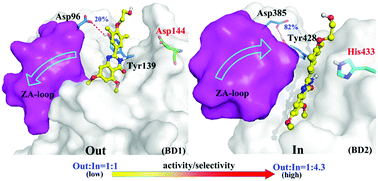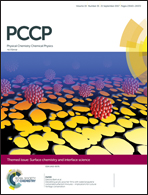Deciphering the mechanisms of selective inhibition for the tandem BD1/BD2 in the BET-bromodomain family†
Abstract
The bromodomain and extra terminal domain (BET) family of bromodomains (BRDs) are well-known drug targets for many human diseases. The active pockets of the two tandem bromodomains BD1/BD2 are highly conserved (sequence similarity is about 95%), thus it is of great medical importance and still a significant challenge to develop BD1/BD2 selective inhibitors. A few BD2 selective inhibitors, such as RVX-208 and RVX-297, have been reported recently. However, their selectivity is insufficient for drug discovery, and the molecular basis of the selective inhibition for BD2 over BD1 remains unknown. In this work, by extensive classical molecular dynamics (MD) simulations and hybrid density functional theory/molecular mechanics (DFT/MM) MD simulations, it is for the first time revealed that the selective inhibitory effect towards BD2 is achieved by the distinctive structural dynamics of the ZA-loop (“in/out” conformations) in BD1 and BD2, which originate from the existence of residue Asp144 in BD1 which is replaced by His433 in BD2. Additionally, the more stable inherent H-bond constructed by a conserved D–Y dyad, as well as the stronger π–π stacking interaction formed between His433 and the ligand, are responsible for the higher inhibitory activity of RVX-297 compared to that of RVX-208 in BD2. All these findings should guide further novel inhibitor design and structural modification of validated BD1/BD2 inhibitors to increase the selectivity for BD1/BD2 among the BET family.

- This article is part of the themed collection: 2017 PCCP HOT Articles


 Please wait while we load your content...
Please wait while we load your content...